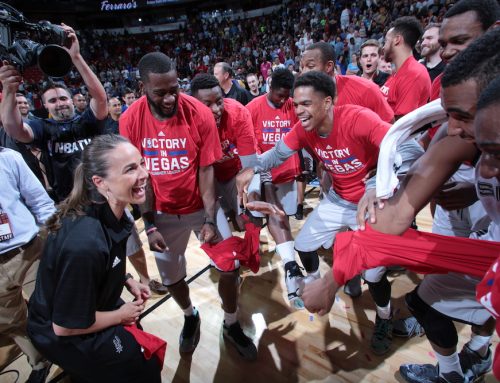via www.espn.go.com
The NBA announced Thursday that it will install motion-tracking cameras in every arena this season to provide coaches, players and fans reams of data aimed at pulling back the curtain on what it takes to succeed at basketball’s highest level.
The NBA has partnered with STATS on the SportVU cameras, and the relationship has grown from a single arena during the 2009 NBA Finals into a league-wide initiative that will be up and ready for the start of this season. The technology can monitor every move a player makes on the court, gauge how tired he is and can even keep an eye on the job referees are doing.
The project makes the NBA the first professional basketball league in the world, and the first sports league in the United States, to use the technology to analyze player movement.
“At this point, given the value of the data both at the team level and the league level, and the promise that it holds for unlocking some of the secrets for what makes great basketball teams, both for our basketball operations people and for our fans at home, we thought it was the right time to make it a league-wide effort,” NBA executive vice president of operations and technology Steve Hellmuth said.
The system of six cameras and accompanying software that delivers the data was first used in Orlando, Fla., during the 2009 Finals between the Magic and the Los Angeles Lakers. In the last three years, 15 teams purchased the system from STATS, which is owned jointly by The Associated Press and 21st Century Fox, to put to use in their home arenas, arming themselves with data that could be tailored virtually any way teams want.
Want to see how successful Ricky Rubio was at guarding Russell Westbrook? The system could break down the shooting percentages and results of each head-to-head possession.
Want to get an idea how close to 100 percent Kevin Love was in his first few games back from a broken hand? The system could send information to the team trainers and doctors about his endurance and how quickly he is tiring during a game, thereby painting the most accurate picture possible of his recovery.
Want to see how many times Al Jefferson touched the ball on the left block in the first half? The system could send information to an iPad that showed the location of every one of his possessions and allowed coaches to make adjustments on the fly.
“It’s gone from an interesting concept to actually something that’s allowing them to take action on a daily basis,” STATS Vice President Brian Kopp said. “That was the big change that we knew we needed to make in order for this to be adopted by the teams. What we always wanted to do was to be at this point and have a partnership with the league itself.”
When only 15 teams were using the technology, scores of games were being missed, which in turn made the sample sizes incomplete. Now, every game and every player will be monitored every night, creating a much more complete database.
“It’s really evolved from a high-level concept, something that seemed interesting, to something that could be actionable and used on a daily basis,” Kopp said.
And the players aren’t the only ones who will be watched by the eye in the sky. Hellmuth said new executive vice president of basketball operations Rod Thorn will be able to use data on referees to more completely evaluate their performances.
Fans will have access to some of the data through presentations by the teams at the arena, on NBA.com and on NBA TV. Hellmuth and Kopp think the most helpful information will come on the defensive end, where stats like blocked shots and steals, while helpful, don’t always paint the most accurate picture of the league’s best defensive players.
“What this can measure is both shooting efficiency and shooting frequency,” Hellmuth said. “When a defender’s in the paint or in the area, players can always choose not to shoot when he’s in the area. And then also how much does that defender reduce the shooting average of the players he’s defending. These are some of the secrets this unlocks.”
The algorithms that are used to interpret the data are constantly being refined, Kopp said, and now can identify certain plays — like a pick-and-roll — and defensive rotations. Now that they are poised to have even more data, the strength and breadth of the information the system can provide should only improve, he said.
“I really do think we’ve just scratched the surface on how we can use this,” Kopp said. “I think the next few years will be fun as we have more data to work with.”



